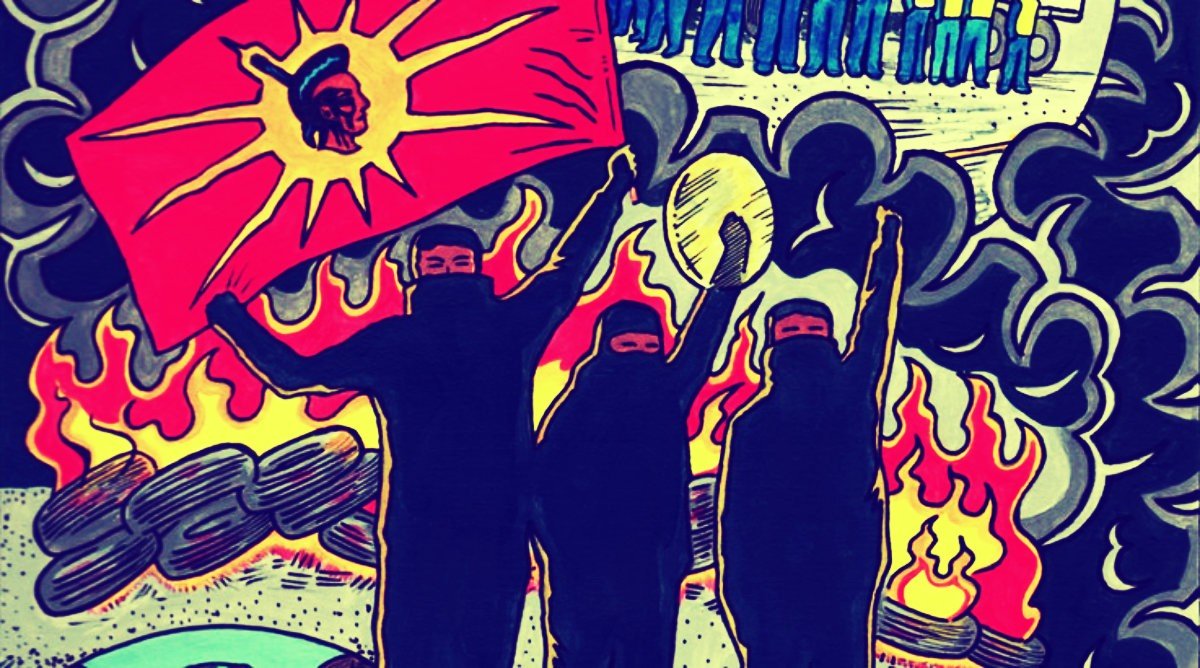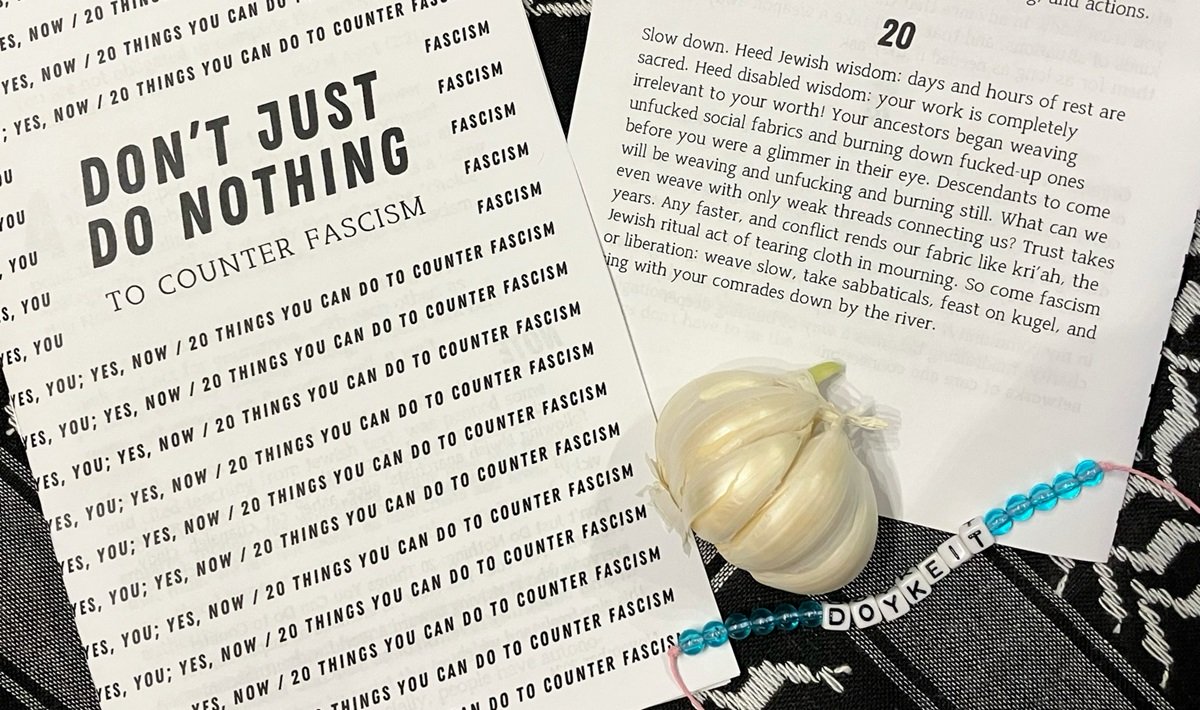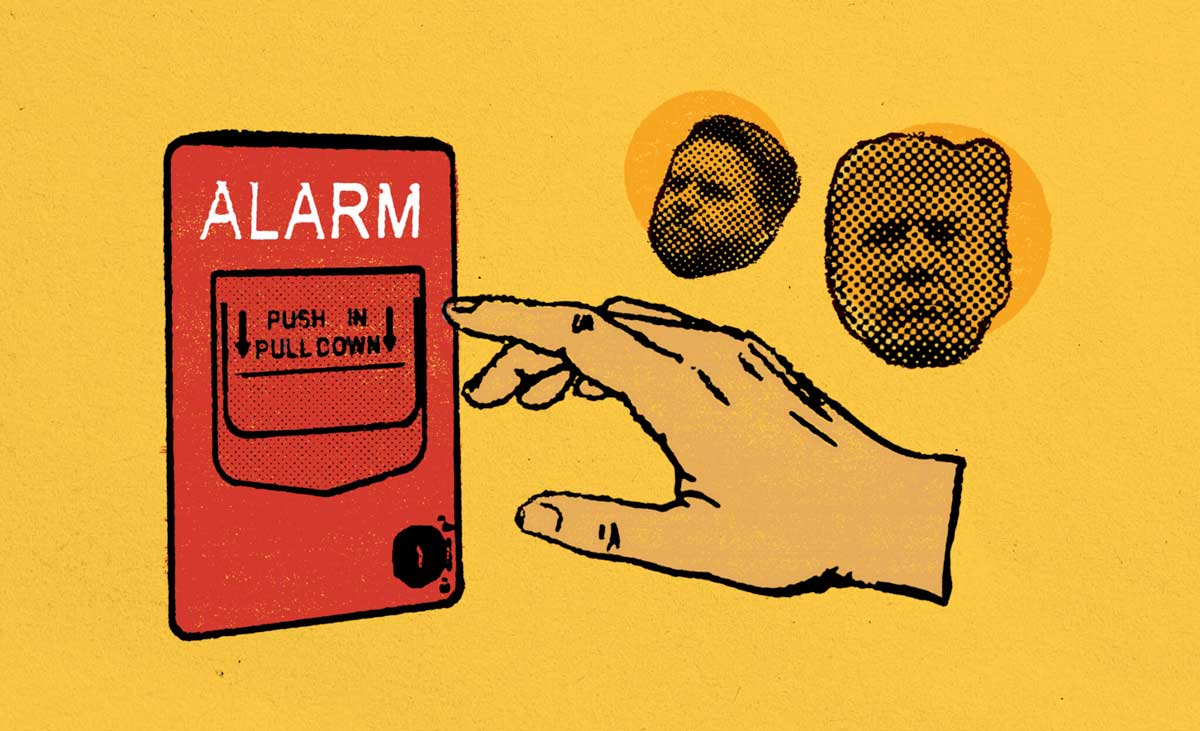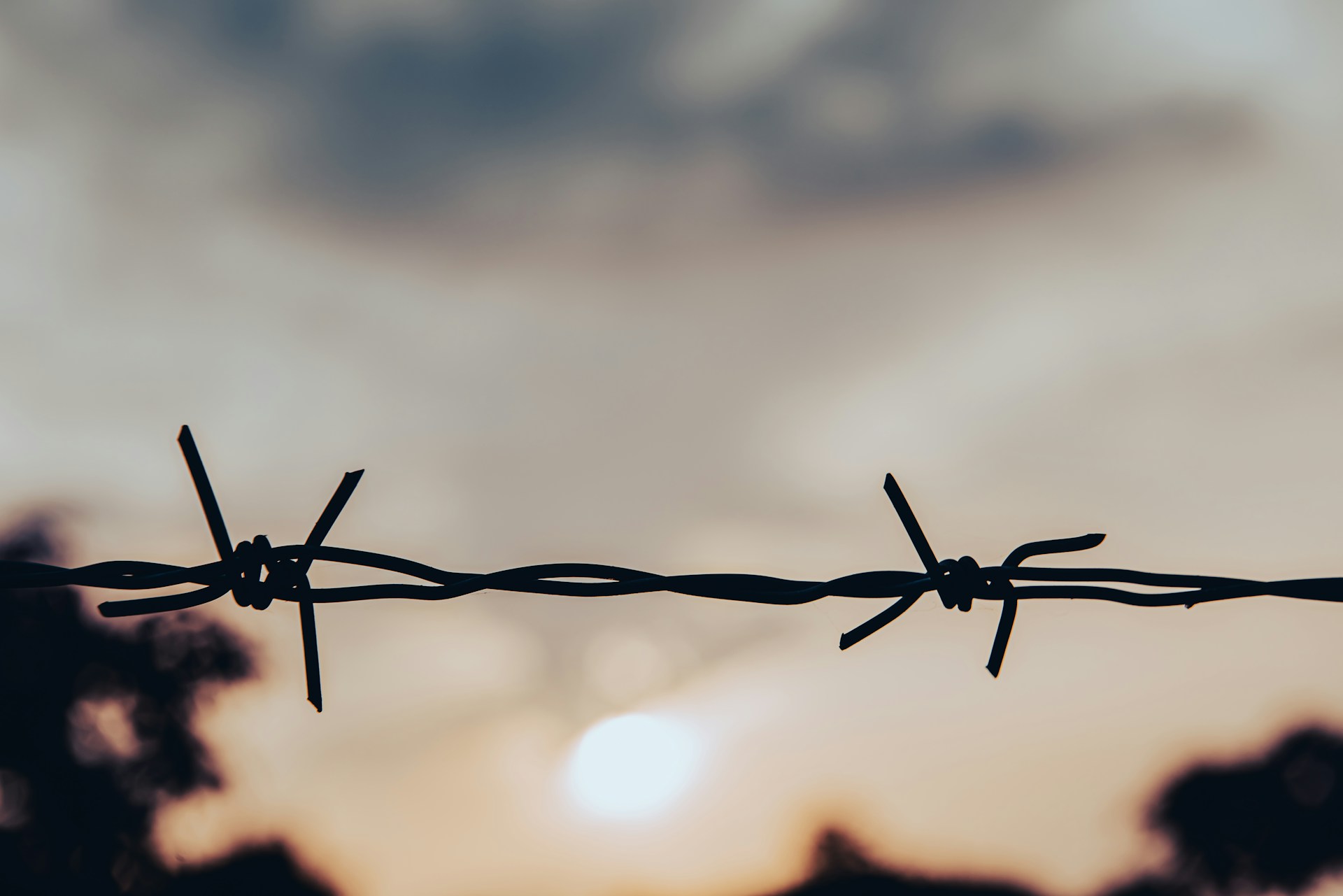Filed under: Analysis, Anarchist Movement, Canada, Indigenous, Land, Solidarity

Discussion on the strategy and history of the disruption and blockading of extractive industries in the context of so-called Canada.
Not only can blockades “shut down the world”, they also open up space for a new one to be built, or in the case of colonized peoples, a world restored. We can look to many of the indigenous blockades or occupations of the last several decades for the examples of ceremonial, culinary, and other socially reproductive practices that point toward new ways of living which are themselves produced through resistance. Similarly, we see the revitalization of warrior culture being expressed at Standing Rock and other moments of indigenous revolt to be indicative of a broader possibility of life without the state or capitalism.[…]
We hold evident that blockades are a crucial tactic in our war against planetary annihilation. […] With this tactical imperative, we call on all warriors and revolutionaries around the world to immediately orient themselves around blockading infrastructure. Collectives must research infrastructure to find the most vulnerable chokepoints and get organized to block them in effective ways. Those without fighting comrades can still contribute by engaging in lone wolf acts of sabotage.
– Disrupt the Flows: War Against DAPL and Planetary Annihilation
We are several settler anarchists in the territory dominated by the Canadian government. Our goal in writing this text is to bring forward some strategic considerations for anarchists who want to contribute to land defense, as well as to publicize some research about the vulnerabilities of Canadian extractive infrastructure for that purpose. We also hope that indigenous communities can use this research to their own ends as well.
We understand the task at hand in our corner of the world as no less than decolonizing the territory dominated by the Canadian government and capitalist economy. Decolonizing this territory necessarily means destroying its colonial governance – a government which depends upon the continuing genocide of indigenous people so that it can maintain sovereignty over the land that it stole. Its system and the way of life it brings is fundamentally built on exploitation of the land and those who inhabit the land.
It’s no secret that the Canadian economy is strongly dependent on ‘natural resource’ exploitation. The transportation infrastructure this economy relies on to get these resources to market, and give them value, is virtually indefensible and its bottlenecks are often close to indigenous communities – which as we will see, is making counter-insurgents panic. Unfortunately, anarchists have rarely engaged with the potential for action and solidarity that this situation of dependency and vulnerability opens up.
We believe that we can’t limit land defense to parcels of territory to be conserved, or settler incursions into treatied territory, because the colonial economy poisons the watershed and spreads destruction beyond these colonial borders. Overthrowing the entire colonial economy is a very long-term undertaking, but in the medium-term we want to build a capacity to block and destroy industrial infrastructure and developments, from pipeline construction to mining and damming operations, to whatever extractive projects indigenous people are resisting. When there is movement capacity, our blockades can become communes; spaces that interweave defense with collective care, and that do away with the laws and logic of capitalism and the government.
We think it’s integral that anarchist contributions to land defense move towards more collective forms of resistance that block infrastructure, as well as face to face relationship-building between anarchist and indigenous communities, but this text will focus on the smaller scale of affinity groups because they are contributions that can happen in the short-term (while impacting the medium- and long-term), and these contributions can happen even when there isn’t a community mobilized against a particular extractive project.
Thinking of how we can contribute in the short-term is valuable to us because most of the time there aren’t escalated tensions around land defense struggles, and we want to act in the present as well as be adequately prepared for when there are. Firstly, contributions in the short-term will help to build an imaginary of how the extractive economy can be resisted in times when there isn’t movement capacity for prolonged occupations, with the goal that these tactics will be taken up more broadly in future social unrest around resource extraction. Also, actions like these can have significant material impacts on extractive projects in the present that have real consequences against the ongoing genocidal project of Canada. Lastly, it can demonstrate to indigenous communities that anarchists are taking risks against shared enemies in our own struggle. We believe this is a prerequisite for powerful solidarity.
As Canada accelerates ecological destruction, and as global warming makes the northern latitudes of Turtle Island of greater strategic and economic value to governments, conflicts between the Canadian government and indigenous people defending the territory will become even more frequent. Anarchists should be prepared to contribute to these moments in a meaningful and effective way, beyond the limited symbolism of actions like banner drops and breaking windows, which have little impact. Being able to step up our solidarity requires developing practices in the present, as well as relationships of struggle between anarchists and indigenous communities engaging in land defense. Such relationships will be essential to moving past the largely limited solidarity expressed through communiques, as well as gauging how different forms of solidarity will be received by different, heterogenous communities in struggle.
In 1990 during the Oka Crisis, when a capitalist development on a Mohawk burial ground created an armed conflict with the Canadian government, sabotage of hydro-electric towers and hard blockades of highways and railways spread like wildfire. This threat of indigenous insurgency is a primary consideration in police operations against any indigenous action, because the government has seen how such sparks can ignite a powderkeg if they don’t tread carefully, particularly when they involve land or treaty claims. During a land defense occupation at Caledonia in 2006, the Commissioner of the OPP explained that he acted on the premise that a misstep on the part of his officers against the occupation would have led to “[a native] flare-up right across the country”, so to deter this greater threat the OPP took no direct action against it [for more on how counter-insurgency strategy has developed since Oka, see From Oka to Caledonia: Assessing the Learning Curve in Intergovernmental Cooperation].
Those who sabotage critical infrastructure, capitalist development, and the police who defend them will unfortunately always be in the minority, but if this minority has a base of social support it is much more difficult to isolate or uproot. This minority’s contributions can have a contagious impact when they inspire others. Being an active minority comes with the risk of instrumentalizing the communities we are in solidarity with, so we are careful to distinguish this path from a vanguardist one:
“The key difference between an influential, insurrectionary minority and a vanguard or a populist group is that the former values its principles and its horizontal relations with society and tries to spread its principles and models without owning them, whereas a vanguard tries to control them – whether through force, charisma, or hiding its true objectives… The influential minority works through resonance, not through control. It assumes risks to create inspiring models and new possibilities, and to criticize convenient lies. It enjoys no intrinsic superiority and falling back on the assumption of such will lead to its isolation and irrelevance. If its creations or criticisms do not inspire people, it will have no influence. Its purpose is not to win followers, but to create social gifts that other people can freely use.”
– The Rose of Fire has Returned
And in the case of critical infrastructure whose disruption has a cascading effect, the counter-insurgents said it well:
“..The hard lessons about just how devastatingly effective a small band of determined and well-led (sic) rebels can be.”
– Douglas Bland
It may be useful to look closer at how these enemies are thinking about indigenous insurgency in Canada. Conservative military analyst Douglas Bland has long warned that Canada’s economic vulnerability is based on the “critical infrastructure that transports natural resources and manufactured goods from mines, oil fields, hydro-electric facilities and factories to international markets.” Without these critical systems, he cautions, “Canada’s economy would collapse.” His writings warn policy makers of the threat of indigenous insurgency in Canada based on ‘Feasibility Theory’. In counter-insurgency literature, predicting the likelihood of insurgency is shifting from a model centered on the motivations of insurgents to a model centered on how feasible an insurgency is in a given context. Grievances that give motivation to insurgency are a constant that can’t be redressed in a context of colonial genocide, or capitalism for that matter. For that reason, counter-insurgents are studying what makes an insurrection feasible to begin with, and then proposing policies aimed at eliminating those conditions to the extent possible.
Feasibility Theory lists five determinants of what makes an insurgency feasible, which Bland argues are all present within the Canadian context, and of which the Canadian government only has some measure of control over the first three. They are:
1) Social Fractionalization – jargon for class and colonial oppression and the threat of indigenous sovereignty. The government seeks to address this through assimilation, buying out communities resisting extractive projects, and structures like band councils that maintain government control over the population through indigenous faces working for colonial interests.
2) Warrior Cohort – young and middle aged men who are likely to become warriors. Bland completely overlooks the ways women and two-spirit people contribute to indigenous resistance. The government tries to reduce this populations ‘recruitement’ into resistance movements through education and training programs aimed at assimilation.
3) Security Guarantee – the perception of the government’s capacity for repression and securing infrastructure. The government tries to minimize the threat of an inadequate security guarantee through funding the training of on-reserve police services. As we saw with the Chateauguay settler riots during the Oka standoff, this repressive function can also be carried out by settler society.
4,5) Commodity Exports & Topography – “Jurisdiction control of the land remains largely undetermined and at issue. Canada’s transportation and energy infrastructure – the backbone of the country’s resource trade – overlays or borders on many of these Aboriginal and disputed lands. With Canadian natural resource development, extraction, and trade representing 25 percent of Canadian GDP, the security of transportation and energy infrastructure is critical. Canada’s transportation and energy infrastructure has considerable vulnerabilities: it covers vast distances, has limited redundancy and multiple choke-points, and is susceptible to cascading effects should disruptions be sustained or widespread. Its vulnerability and resulting risk to the Canadian economy is significant, and sustained disruption would have catastrophic effects with a matter of weeks.” Topography and reliance on exports are the two determinants that are impossible to change. In fact, Canada is slated to become more dependent on its export economy in the coming years.
All that said, we don’t need proof of the feasibility of indigenous insurgency from a white academic. We see it in the consistent history of indigenous resistance to genocide since contact, and recently in flareups at Oka, Ipperwash, Ts’Peten, Caledonia, Six Nations, Elsipogtog and across the territory during Idle No More.
The appendixes that follow take a look at how extractive infrastructure is vulnerable in more detail. We hope they prove valuable to affinity groups and communities fighting the extractive economy across the territory.





